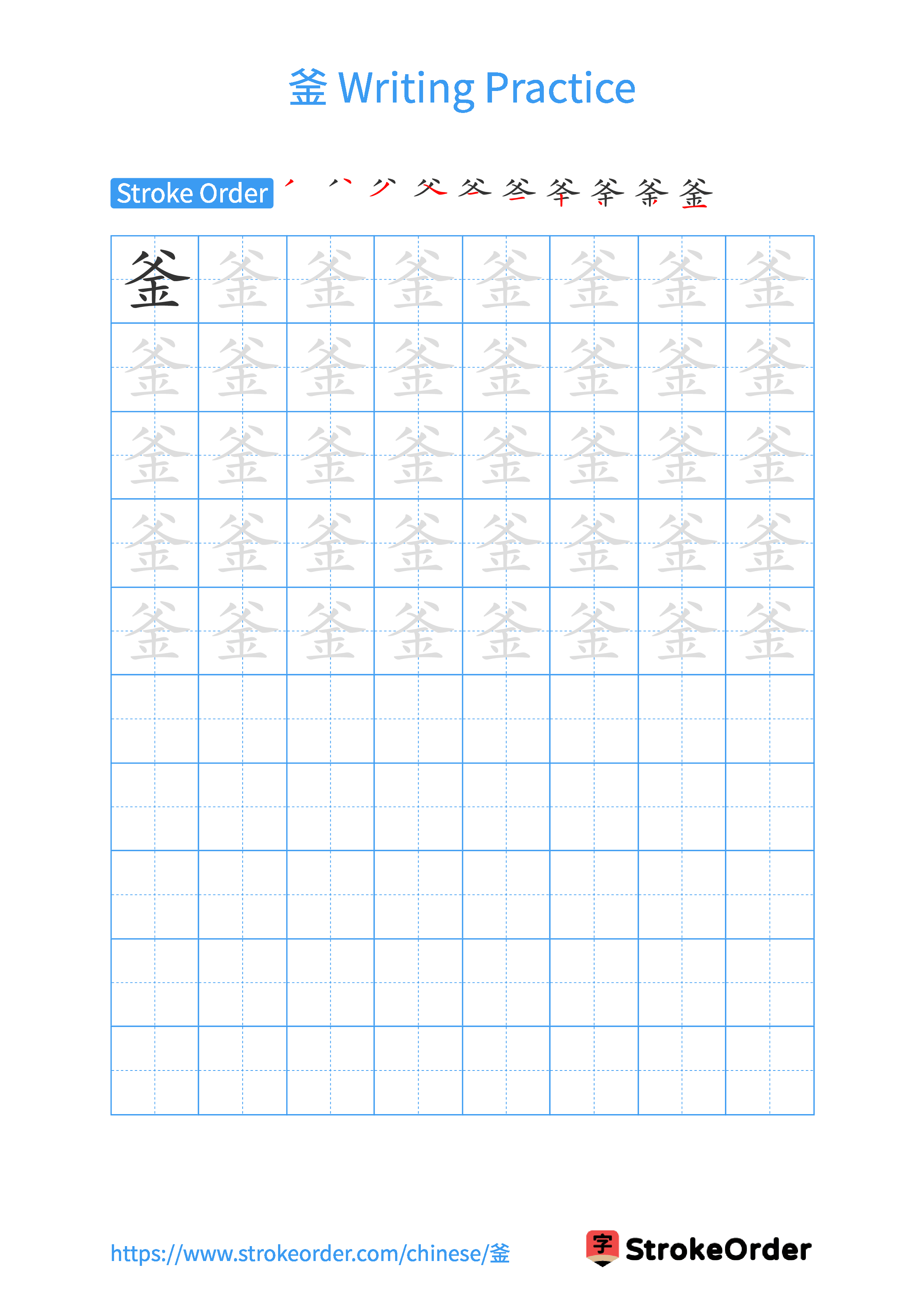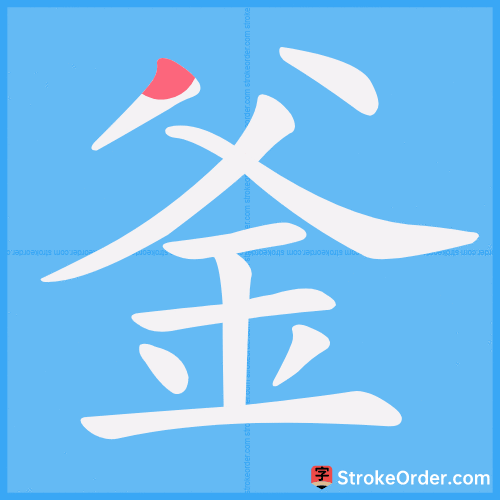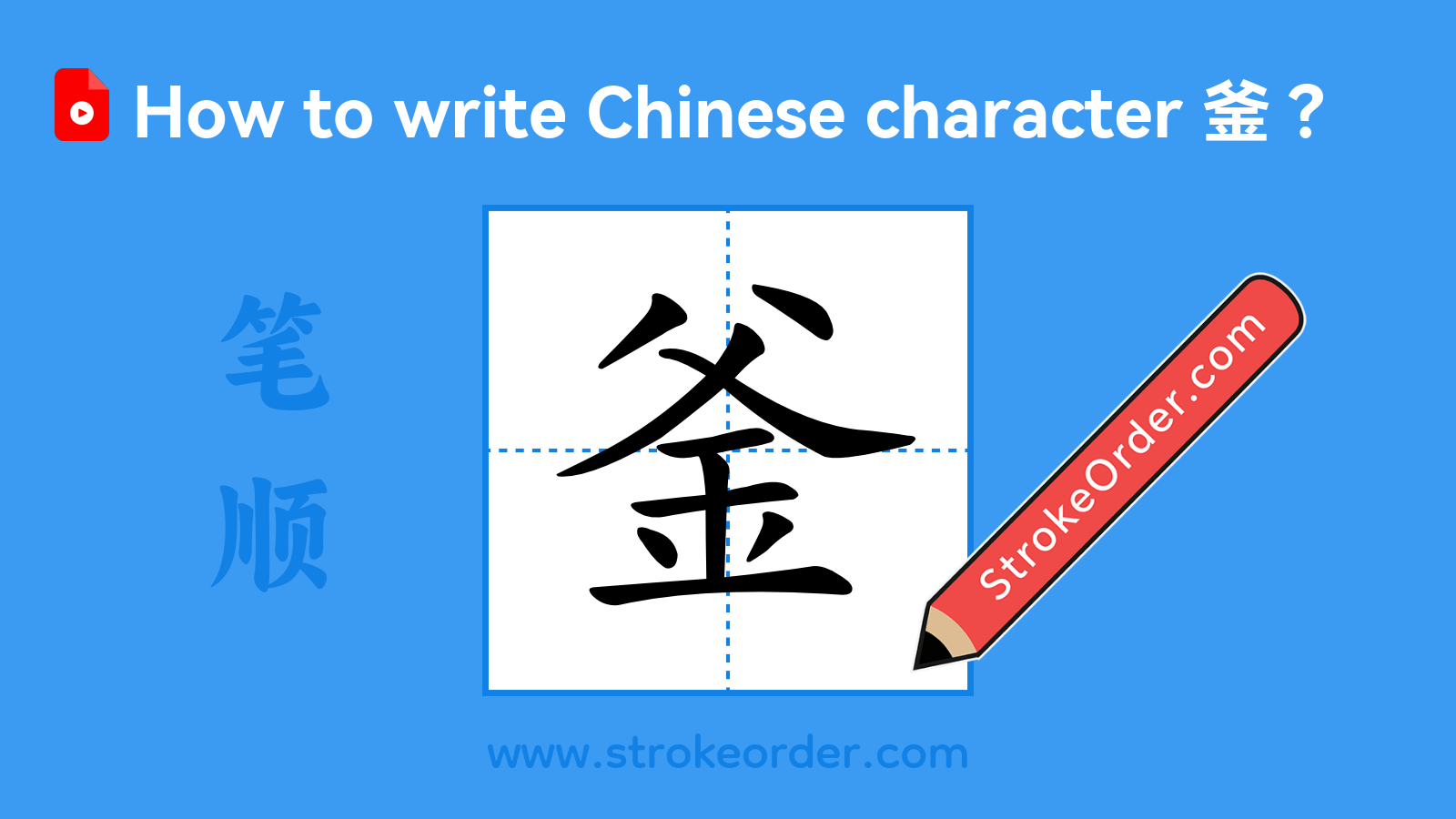釜 Stroke Order
Animated Stroke Order of 釜
Stroke Order Diagrams for 釜
Step-by-Step Handwriting Guide for 釜
Learn to Write Chinese Characters with Video Tutorials
Watch the video of writing the Chinese character "釜", learn the correct stroke order (笔顺) of the character "釜", and master the standard way of writing the character "釜".
Free Printable Handwriting Practice with Stroke Order: 釜
Printable Writing Practice Worksheet of "釜" in Portrait Orientation (Tian Zi Ge)

Printable Writing Practice Worksheet of "釜" in Landscape Orientation (Tian Zi Ge)

Information of 釜
Pinyinfǔ
Radical
金
Strokes
10 strokes
Usage
★★★★
Definition
kettle / caldron
釜 [fǔ] 名1. 古代的一种锅。 (1) An ancient type of pot or cauldron used in cooking.例如: ~底抽薪。破~沉舟。(For example: "Removing the firewood from under the cauldron." "Breaking the cauldron to sink the boat.") 2. 中国春秋战国时期量器名,亦是容量单位,标准不一。 (2) A name of a measuring vessel during the Spring and Autumn and Warring States periods in China, which also served as a unit of capacity with varying standards.例如: 釜中生鱼 (Fish born in the cauldron - metaphor for living in poverty).釜鱼假息 (Metaphor for something that cannot last long). 3. 【本义】: 古炊器。敛口圜底,或有二耳。其用于鬲,置于灶,上置甑以蒸煮。盛行于汉代。有铁制的,也有铜或陶制的。 (3) The original meaning: An ancient cooking vessel; it has a narrowed top and a rounded bottom, sometimes with two ears. It is used with a tripod (e.g., "li") placed over a fire, while a steamer is placed on top for cooking. This vessel was popular during the Han Dynasty and was made from iron, copper, or pottery.4. 【造字法】: 形声。从金省,父声。 (4) Method of character formation: Phono-semantic compound. The component suggests metal (金) and the phonetic component is 父. 5. 现有战国时的禾子釜和陈纯釜,都作坛形,小口大腹,有两耳。 (5) Existing examples from the Warring States period include the "hezi fu" and "Chen Chun fu," both of which are jar-shaped with small openings and larger bellies, featuring two ears. 6. 引用: 曹植《七步诗》:萁在釜下燃,豆在釜中泣。 (6) Reference: "In the cauldron, the dangshen burns, while the beans weep within." (Cao Zhi, "Seven Steps Poem") 7. 例: 釜鱼假息 (比喻不能久存);釜底游魂 (比喻行将灭亡、苟延残喘的人)。 (7) Examples: "Cauldron fish holding onto breaths" (a metaphor for things that cannot last long); "Souls swimming in the cauldron" (a metaphor for people who are on the verge of extinction). 8. 古量器名称,流行于齐国。 (8) An ancient measuring vessel name, prevalent in the state of Qi during the Spring and Autumn and Warring States periods. 例如: 釜庾 (The cauldron and the "yu," both are names of ancient measuring vessels, indicating a small quantity). 釜鼓 (The cauldron and drum, both names of ancient measuring vessels). 釜钟 (The cauldron and the bell, both names of ancient measuring vessels, also refer to a small quantity).
lit. to break the cauldrons and sink the boats (idiom); fig. to cut off one's means of retreat / to burn one's boats
to take drastic measures to deal with a situation / to pull the carpet from under sb
Busan Metropolitan City in South Gyeongsang Province 慶尚南道|庆尚南道[Qing4 shang4 nan2 dao4], South Korea
Input Method for 釜
Pinyinfu3
Wubi
wqfu|wrfu
Cangjie
ckmgc
Zhengma
oocu
Four Corner
80109
Unicode
U+91dc
Same Pronunciation Characters
付伏俘俯傅副咐复夫妇孵富幅府弗扶抚拂敷斧服浮父甫福符缚肤脯腐腹芙袱覆负赋赴辅辐附凫匐呋呒孚幞怫拊桴氟涪滏祓稃绂罘腑芾苻茀茯莩菔蚨蜉蝮
Same Radical Characters
金鉴釜銮鋈錾鍪鎏鏊鏖鐾鑫銎鎣鑒鑾鑿銐錖鐜鍙鋻鍳銞鋫錅鏧鎜鋬錃鐅鍫鑋銴鐆鋚鎥鍌鑍鋆鏨銺錱鈭鐢䥒䥆䥢䥸䥐䥅䤰䥣䥌䥭䥍䥚
本文来自蝶舞╰︶櫻婲落ペ投稿,不代表汉字笔顺中文网英文版立场,如若转载,请注明出处:https://www.strokeorder.cn/strokeorder/14064.html





 微信扫一扫
微信扫一扫 